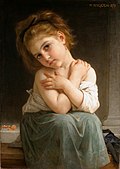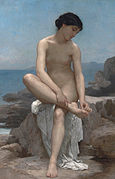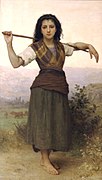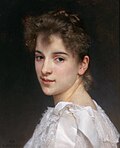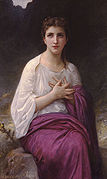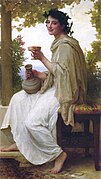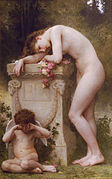William-Adolphe Bouguereau: Difference between revisions
| Line 307: | Line 307: | ||
* [http://www.ibiblio.org/wm/paint/auth/bouguereau/ ibiblio.org Bouguereau Web Museum] |
* [http://www.ibiblio.org/wm/paint/auth/bouguereau/ ibiblio.org Bouguereau Web Museum] |
||
*[http://www.xs4all.nl/~frqnc23/framesen.html Catalog of Bouguereau works] |
*[http://www.xs4all.nl/~frqnc23/framesen.html Catalog of Bouguereau works] |
||
*[http://www.all-art.org/neoclasscism/bouguereau1.html Adolphe William Bouguereau - Life and Works] |
|||
<!-- Metadata: see [[Wikipedia:Persondata]] --> |
<!-- Metadata: see [[Wikipedia:Persondata]] --> |
||
{{Persondata |
{{Persondata |
||
Revision as of 04:35, 28 February 2011
This article relies largely or entirely on a single source. (December 2010) |
William-Adolphe Bouguereau | |
|---|---|
 Self-Portrait (1879) | |
| Born | William-Adolphe Bouguereau |
| Nationality | French |
| Known for | Painter |
| Notable work | The Birth of Venus The Bohemian |
| Movement | Realism |
William-Adolphe Bouguereau (November 30, 1825 – August 19, 1905) was a French academic painter. William Bouguereau (French pronunciation: [vijɑ̃ buɡøʁo]) was a traditionalist whose realistic genre paintings and mythological themes were modern interpretations of Classical subjects with a heavy emphasis on the female human body.
Although he created an idealized world, his almost photo-realistic style was popular with rich art patrons. He was very famous in his time but today his subject matter and technique receive relatively little attention compared to the popularity of the Impressionists.
Life and career
William-Adolphe Bouguereau was born in La Rochelle, France on November 30, 1825, into a family of wine and olive oil merchants. He seemed destined to join the family business but for the intervention of his uncle Eugène, a Roman Catholic priest, who taught him classical and Biblical subjects, and arranged for Bouguereau to go to high school. Bouguereau showed artistic talent early on and his father was convinced by a client to send him to the École des Beaux-Arts in Bordeaux, where he won first prize in figure painting for a depiction of Saint Roch. To earn extra money, he designed labels for jams and preserves.[1]
Through his uncle, Bouguereau was given a commission to paint portraits of parishioners, and when his aunt matched the sum he earned, Bouguereau went to Paris and became a student at the École des Beaux-Arts.[2] To supplement his formal training in drawing, he attended anatomical dissections and studied historical costumes and archeology. He was admitted to the studio of François-Edouard Picot, where he studied painting in the academic style. Academic painting placed the highest status on historical and mythological subjects and Bouguereau won the coveted Prix de Rome in 1850, with his Zenobia Found by Shepherds on the Banks of the Araxes.[3] His reward was a stay at the Villa Medici in Rome, Italy, where in addition to formal lessons he was able to study first-hand the Renaissance artists and their masterpieces.
Bouguereau, painting entirely within the traditional Academic style, exhibited at the annual exhibitions of the Paris Salon for his entire working life.

An early reviewer stated, “M. Bouguereau has a natural instinct and knowledge of contour. The eurythmie of the human body preoccupies him, and in recalling the happy results which, in this genre, the ancients and the artists of the sixteenth century arrived at, one can only congratulate M. Bouguereau in attempting to follow in their footsteps…Raphael was inspired by the ancients…and no one accused him of not being original.”[4]
Raphael was a favorite of Bouguereau and he took this review as a high compliment. He had fulfilled one of the requirements of the Prix de Rome by completing an old-master copy of Raphael’s The Triumph of Galatea. In many of his works, he followed the same classical approach to composition, form, and subject matter.[5] Bouguereau's graceful portraits of women were considered very charming, partly because he could beautify a sitter while also retaining her likeness.
In 1856, he married Marie-Nelly Monchablon and subsequently had five children. By the late 1850s, he had made strong connections with art dealers, particularly Paul Durand-Ruel (later the champion of the Impressionists), who helped clients buy paintings from artists who exhibited at the Salons.[6]Thanks to Paul Durand-Ruel, Bouguereau met Hugues Merle, who later often was compared to Bouguereau. The Salons annually drew over 300,000 people, providing valuable exposure to exhibited artists.[7] Bouguereau’s fame extended to England by the 1860s, and he bought a large house and studio in Montparnasse with his growing income.[8]
Bouguereau was a staunch traditionalist whose realistic genre paintings and mythological themes were modern interpretations of Classical subjects—both pagan and Christian—with a heavy concentration on the female human body. The idealized world of his paintings, and his almost photo-realistic style, brought to life goddesses, nymphs, bathers, shepherdesses, and madonnas in a way that appealed to wealthy art patrons of the era. Some critics, however, preferred Jean-François Millet’s less-idealized depictions of hard-working farmers and laborers.
Bouguereau employed traditional methods of working up a painting, including detailed pencil studies and oil sketches, and his careful method resulted in a pleasing and accurate rendering of the human form. His painting of skin, hands, and feet was particularly admired.[9] He also used some of the religious and erotic symbolism of the Old Masters, such as the “broken pitcher” which connoted lost innocence.[10]
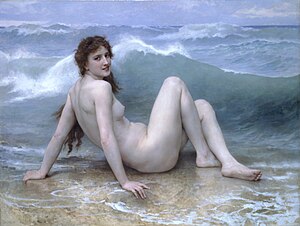
Bouguereau received many commissions to decorate private houses, public buildings, and churches. As was typical of such commissions, Bouguereau would sometimes paint in his own style, and at other times conform to an existing group style. Early on, Bouguereau was commissioned in all three venues, which added enormously to his prestige and fame. He also made reductions of his public paintings for sale to patrons, of which The Annunciation (1888) is an example.[11] He was also a successful portrait painter and many of his paintings of wealthy patrons remain in private hands.[12]
Bouguereau steadily gained the honors of the Academy, reaching Life Member in 1876, and Commander of the Legion of Honor and Grand Medal of Honor in 1885.[13] He began to teach drawing at the Académie Julian in 1875, a co-ed art institution independent of the École des Beaux-Arts, with no entrance exams and with nominal fees.[14]
In 1877, both his wife and infant son died. At a rather advanced age, Bouguereau was married for the second time in 1896, to fellow artist Elizabeth Jane Gardner Bouguereau, one of his pupils.[15] He used his influence to open many French art institutions to women for the first time, including the Académie française.
Near the end of his life he described his love of his art: “Each day I go to my studio full of joy; in the evening when obliged to stop because of darkness I can scarcely wait for the next morning to come…if I cannot give myself to my dear painting I am miserable”.[16] He painted eight hundred and twenty-six paintings.
In the spring of 1905, Bouguereau's house and studio in Paris were robbed. On August 19, 1905, Bouguereau died in La Rochelle at the age of 79 from heart disease.
Fame and fall

In his own time, Bouguereau was considered to be one of the greatest painters in the world by the Academic art community, and simultaneously he was reviled by the avant-garde. He also gained wide fame in Belgium, Holland, Spain, and in the United States, and commanded high prices.[12]
Bouguereau’s career was a nearly straight up ascent with hardly a setback.[17] To many, he epitomized taste and refinement, and a respect for tradition. To others, he was a competent technician stuck in the past. Degas and his associates used the term “Bouguereauté” in a derogatory manner to describe any artistic style reliant on “slick and artificial surfaces”,[17] also known as a licked finish. In an 1872 letter, Degas wrote that he strove to emulate Bouguereau’s ordered and productive working style, although with Degas' famous trenchant wit, and the aesthetic tendencies of the Impressionists, it is possible the statement was meant to be ironic.[18]
Bouguereau’s works were eagerly bought by American millionaires who considered him the most important French artist of that time.[12] But after 1920, Bouguereau fell into disrepute, due in part to changing tastes and partly to his staunch opposition to the Impressionists who were finally gaining acceptance. For decades following, his name was not even mentioned in encyclopedias.
His name
Sources on his full name are contradictory: some[weasel words] give William-Adolphe Bouguereau (composed name), William Adolphe Bouguereau (usual and civil-only names according to the French tradition), while others[weasel words] give Adolphe William Bouguereau (with Adolphe as the usual name). However, the artist used to sign his works simply as William Bouguereau (hinting "William" was his given name, whatever the order), or more precisely as "W.Bouguereau.date" (French alphabet) and later as "W-BOVGVEREAV-date" (Latin alphabet).

Bouguereau as a teacher
From the 1860s, Bougureau was closely associated with the Académie Julian where he gave lessons and advice to art students, male and female, from around the world. During several decades he taught drawing and painting to literally hundreds, if not thousands of students. Many of them managed to establish artistic careers in their own countries, sometimes following his academic style, and in other cases, rebelling against it, like Henri Matisse.
Legacy
In 1974, the New York Cultural Center staged a show of Bouguereau's work as a curiosity. In 1984, the Borghi Gallery hosted the commercial show of his 23 oil paintings and 1 drawing. In the same year a major exhibition was organized by the Montreal Museum of Fine Arts, in Canada. The exhibition opened at the Musée du Petit-Palais, in Paris, traveled to The Wadsworth Atheneum in Hartford, and concluded in Montréal. This was the beginning of renewal of interest about Bouguereau[citation needed]. In 1997 Mark Borghi and Laura Borghi organized an early Internet exhibition. Bouguereau present day supporters also include New Jersey millionaire, businessman, and art collector Fred Ross whose internet-based Art Renewal Center heavily features Bouguereau's work as part of their advocacy for the re-appreciation of academic art.[19] Today, over one hundred museums throughout the world exhibit Bouguereau's works[citation needed].
Selected works
- La Danse (1850)
- Alone in the World (Latest 1867)
- The Knitting Girl (1869)
- Nymphs and Satyr (1873)
- Cupidon (1875)
- The Birth of Venus (1879)
- Evening Mood (1882)
- The Nut Gatherers (1882)
- The Young Shepherdess (1885)
- Chapel of the Virgin, Saint-Vincent-de-Paul church, Paris (1885–89)
- Le Printemps (The Return of Spring) (1886)
- Premier Deuil (The First Mourning) (1888)
- The Shepherdess (1889)
- L'Amour et Psyché, enfants (1890)
- The Bohemian (1890)
References
- Albert Boime: The Academy and French Painting in the Nineteenth Century (London, 1971).
- Aleska Celebonovic: Peinture kitsch ou réalisme bourgeois, l'art pompier dans le monde. Paris: Seghers, 1974.
- Art Pompier: Anti-Impressionism. New York: The Emily Lowe Gallery, Hofstra University, 1974.
- Mario Amaya (Forward), Robert Isaacson (catalogue and selection): William Adolphe Bouguereau. New York: New York Cultural Center, 1974.
- John Russell: Art: Cultural Center Honors Bouguereau. In New York Times, 1974.
- Louise d 'Argencourt and Douglas Druick: The Other Nineteenth Century. Ottawa: The National Gallery of Canada, 1978.
- James Harding: Les peintres pompiers. Paris: Flammarion, 1980.
- "The Bouguereau Market". The Art newsletter. January 6, 1981. pp. 6–8.
- Louise d'Argencourt and Mark Steven Walker: William Bouguereau. Montreal, Canada: The Montreal Museum of Fine Arts, 1984.
- Robert Rosenblum and H.W. Janson: 19th Century Art. New York: Harry N. Abrams, 1984.
- Michael Gibson: Bouguereau's "Photo-Idealism". In International Herald Tribune, 1984.
- Grace Glueck: To Bouguereau, Art Was Strictly "The Beautiful. In The New York Times, 1985.
- Cécile Ritzenthaler: L'école des beaux art du XIXe siècle. édition Mayer, 1987
- Exhibition catalogue William Adolphe Bouguereau, L'Art Pompier. Borghi & Co., New York, 1991.
Gallery
1850s
-
Dante and Virgil in Hell (1850)
-
A Portrait of Amelina Dufaud Bouguereau (1850)
-
A Portrait of Eugène Bouguereau (1850)
-
A Portrait of Geneviève Bouguereau (1850)
-
A Portrait of Léonie Bouguereau (1850)
-
Portrait of Monsieur M. (1850)
-
Fraternal Love (1851)
-
Canephores (1852)
-
Arion on a Sea Horse (1855)
-
Bacchante on a Panther (1855)
-
The Dance (1856)
-
Charity (1859)
-
The Day of the Dead (1859)
1860s
-
Tobias Saying Good-Bye to his Father (1860)
-
Young Woman Contemplating Two Embracing Children (1861)
-
The Remorse of Orestes (1862)
-
The Prayer (1865)
-
Soup (1865)
-
Premières Caresses (1866)
-
Gypsy Girl with a Basque Drum (1867)
-
Yvonnette (1867)
-
The Bunch Of Grapes (1868)
-
Young Shepherdess (1868)
-
The Elder Sister (1869)
-
The Haymaker (1869)
-
The Knitting Girl (1869)
-
Maternal Admiration (1869)
-
Washerwomen of Fouesnant (1869)
-
Young Worker (1869)
-
Seule au monde (before 1867)
1870s
-
Bather (1870)
-
Breton Brother and Sister (1871)
-
Italian Girl Drawing Water (1871)
-
Young Mother Gazing At Her Child (1871)
-
Pendant l'Orage (1872)
-
The Proposal (1872)
-
Nymphs and Satyr (1873)
-
The Spinner (1873)
-
Child Braiding A Crown (1874)
-
Homer and his Guide (1874)
-
The Storm (1874)
-
After the Bath (1875)
-
At the Edge of the Brook (1875)
-
Cupidon (1875)
-
Lullaby (1875)
-
The Virgin, Jesus & Saint John Baptist (1875)
-
Pieta (1876)
-
Integrity (1876)
-
Charity (1878)
-
The Nymphaeum (1878)
-
Return from the Harvest (1878)
-
At the Edge of the Brook (1879)
-
The Birth of Venus (1879)
-
Rest (1879)
-
Young Gypsies (1879)
-
La Frileuse (1879)
-
Tricoteuse (1879)
-
Mademoiselle Elizabeth Gardner (1879)
-
The Bather (1879)
1880s
-
The Flagellation of Our Lord Jesus Christ (1880)
-
Temptation (1880)
-
A Young Girl Defending Herself Against Eros (1880)
-
Dawn (1881)
-
Day (1881)
-
The Shepherdess (1881)
-
Song of the Angels (1881)
-
Evening Mood (1882)
-
The Little Knitter (1882)
-
The Nut Gatherers (1882)
-
The Motherland (1883)
-
La Nuit (1883)
-
Biblis (1884)
-
Crown of Flowers (1884)
-
The Difficult Lesson (1884)
-
The Horseback Ride (1884)
-
Seated Nude (1884)
-
Lost Pleiad (1884)
-
The Youth of Bacchus (1884)
-
Love's Resistance (1885)
-
Young Girl Going to the Spring (1885)
-
The Young Shepherdess (1885)
-
Big Sis' (1886)
-
Return of Spring (1886)
-
Self-Portrait Presented To M. Sage (1886)
-
Thirst (1886)
-
Brother And Sister (1887)
-
Young Shepherdess Standing (1887)
-
Premier Deuil or The First Mourning (1888)
-
Study: Head Of A Little Girl (1888)
-
Psyche and Cupid (1889)
-
The Little Shepherdess (1889)
-
The Shepherdess (1889)
-
Whisperings of Love (1889)
-
Young Girl Crocheting (1889)
1890s
-
L'Amour et Psyché, enfants (1890)
-
The Bohemian (1890)
-
A Little Coaxing (1890)
-
Love on the Look Out (1890)
-
Portrait of Gabrielle Cot (1890)
-
The Broken Pitcher (1891)
-
The Goose Girl (1891)
-
Work Interrupted (1891)
-
Psyche (1892)
-
The Invasion (1893)
-
Youth (1893)
-
After the Bath (1894)
-
Bacchante (1894)
-
Daisies (1894)
-
The Palm Leaf (1894)
-
The Abduction of Psyche (1895)
-
In Penitence (1895)
-
Not Too Much To Carry (1895)
-
The Song of the Nightingale (1895)
-
Spring Breeze (1895)
-
A Calling (1896)
-
Meditation (1896)
-
At The Fountain (1897)
-
Compassion (1897)
-
Irène (1897)
-
The Curtsey (1898)
-
Head Of A Young Girl (1898)
-
Inspiration (1898)
-
Sewing (1898)
-
Elegy (1899)
-
Girl Holding Lemons (1899)
-
La Vierge au Lys (1899)
-
Mailice (1899)
1900s
Notes
- ^ Fronia E. Wissman, Bouguereau, Pomegranate Artbooks, Rohnert Park, CA, 1996, ISBN 0-87654-582-7, p. 11
- ^ Fronia E. Wissman, 1996, p. 11
- ^ Fronia E. Wissman, 1996, p. 12
- ^ Fronia E. Wissman, 1996, p. 24
- ^ Fronia E. Wissman, 1996, p. 25
- ^ Fronia E. Wissman, 1996, p. 13
- ^ Fronia E. Wissman, 1996, p. 70
- ^ Fronia E. Wissman, 1996, p. 14
- ^ Fronia E. Wissman, 1996, p. 112
- ^ Fronia E. Wissman, 1996, p. 60
- ^ Fronia E. Wissman, 1996, p. 31
- ^ a b c Fronia E. Wissman, 1996, p. 103
- ^ Fronia E. Wissman, 1996, p. 16
- ^ Fronia E. Wissman, 1996, p. 110
- ^ Fronia E. Wissman, 1996, p. 15
- ^ Fronia E. Wissman, 1996, p. 114
- ^ a b Fronia E. Wissman, 1996, p. 9
- ^ Fronia E. Wissman, Bouguereau, page 103
- ^ Roth, Mark. "Gifted artist? Bouguereau's work controversial more than a century after his death", Pittsburgh Post-Gazette, 21 August 2007. Retrieved 8 September 2007
External links
- 288 works by William-Adolphe Bouguereau (www.bouguereau.org)
- Biography of William Bouguereau (Art Renewal Center)
- Bouguereau Gallery at MuseumSyndicate
- Getty Research Institute Bouguereau material, including letters
- ibiblio.org Bouguereau Web Museum
- Catalog of Bouguereau works
- Adolphe William Bouguereau - Life and Works

























































